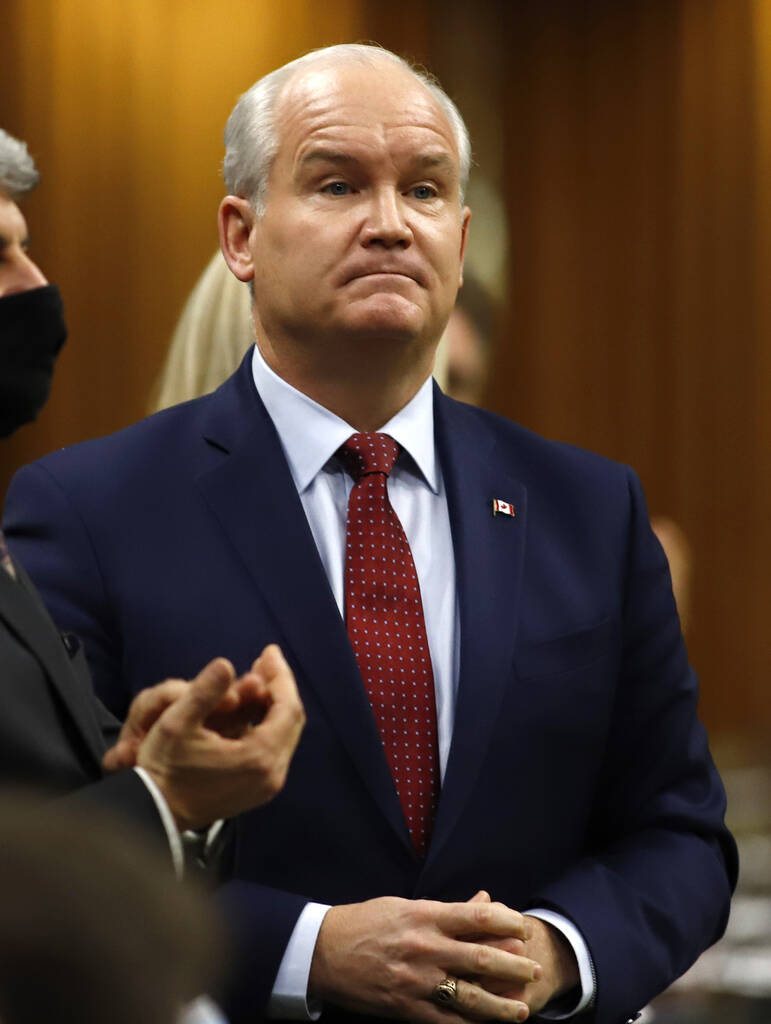No small challenge for next CPC leader
Read this article for free:
or
Already have an account? Log in here »
To continue reading, please subscribe:
Monthly Digital Subscription
$19 $0 for the first 4 weeks*
- Enjoy unlimited reading on winnipegfreepress.com
- Read the E-Edition, our digital replica newspaper
- Access News Break, our award-winning app
- Play interactive puzzles
*No charge for four weeks then billed as $19 plus GST every four weeks. Offer only available to new and qualified returning subscribers. Cancel any time.
Read unlimited articles for free today:
or
Already have an account? Log in here »
Hey there, time traveller!
This article was published 03/02/2022 (1055 days ago), so information in it may no longer be current.
With Erin O’Toole out as leader, the Conservative Party of Canada is inexorably headed in a different direction. That much is clear.
Beyond that, however, there’s mostly uncertainty about what the CPC is, what it aspires to be and whose interests and political designs it intends to serve.
What we know, in the aftermath of Wednesday’s caucus gathering that saw Conservative MPs vote 73-45 in favour of removing Mr. O’Toole from the position he held for less than two years and through one unsuccessful (albeit not in terms of popular vote) federal election, is that a majority of the CPC’s elected members do not share their erstwhile leader’s view of where the party’s best chance at gaining power lies.

Despite having portrayed himself as a true-blue Conservative when he sought and won the leadership over longtime Tory insider Peter MacKay in 2020, Mr. O’Toole quickly demonstrated that such positioning was more tactical that ideological. Having secured the leadership, he promptly sought to establish a more centrist agenda in the belief the CPC’s best chance at defeating Justin Trudeau’s Liberals was moderation rather than harder-right antagonism.
This on-the-fly rebranding didn’t convince enough voters in Quebec and Ontario to vote against Mr. Trudeau; worse yet, it infuriated many in the party’s western wing who were looking for a non-traditional, angrier brand of conservatism that features echoes of the populist defiance currently in fashion south of the border.
In particular, Mr. O’Toole’s stances on such issues as deficit spending, COVID-19 vaccination and a carbon tax to fight climate change ran him afoul of more stridently right-leaning Tories (last year, the CPC’s membership would not even support a resolution agreeing climate change itself is real).
And when the so-called “freedom convoy” rolled into Ottawa, essentially demanding a “with us, or against us” declaration from politicians of all stripes, but particularly those carrying CPC credentials, the only thing left for Mr. O’Toole was to waffle on supporting the truckers, then get run over by populist outrage and run out of town by his party.
So, where to next for the Conservative Party of Canada? That’s an interesting question that likely has at least a couple of answers — neither particularly satisfying — for its devotees. It can take what now seems the obvious step, by hewing harder to the right in an effort to appease its most vocal and publicly aggrieved members, which might solidify its internal support but will almost certainly guarantee another term — perhaps with the majority he so dearly desires — for Mr. Trudeau.
The appointment of rural Manitoba MP Candice Bergen as interim leader, and indications that populist insider Pierre Poilievre is the leading as-yet-undeclared candidate for the vacant job, certainly suggests an inclination to head down this path.
Or, perhaps, the CPC can look for a more nuanced manner of extrication from its current factionalized predicament. That would require a new leader capable of knitting together the frayed fabric of the party and presenting “vote Conservative” as a palatable alternative to the broader public in a way that hasn’t been seen since the heady days of Stephen Harper’s prime-ministership.
In an internet-entralled era in which the most polarized views within the CPC have become entangled with anti-vaxx/anti-lockdown sentiments and amplified, attitudinally, by across-the-border echoes of Trump-supporting ire, finding a measured, moderate path toward electoral success seems like a challenge beyond the reach of any currently identifiable prospective CPC leader.
It certainly proved to be the undoing of the last guy to try it.













